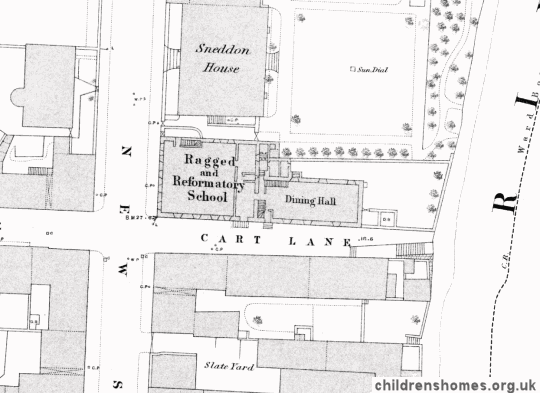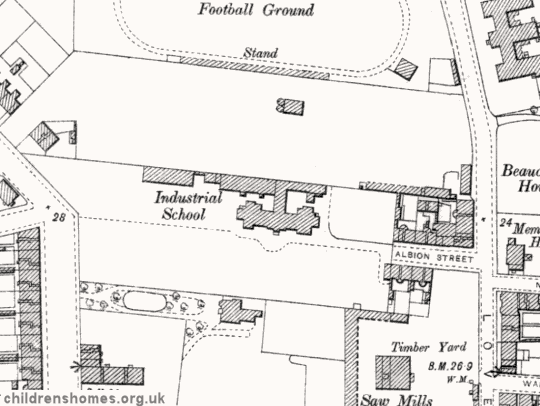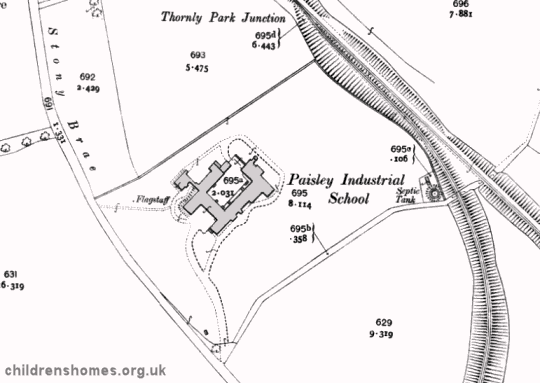Paisley Ragged and Industrial School / Thornly Park Approved School, Renfrewshire, Scotland
On 11 April 1847, a meeting of committees from the Town Council and from the Burgh and Abbey Parochial Boards was held in Paisley's Council Chamber, to discuss the subject of establishing a ragged school in the town. Three days later, a further meeting in the Court Hall was attended by magistrates, members of Council, ministers of all denominations, members of the Parochial Boards, bankers, merchants, and other influential inhabitants. The meeting appointed a committee to pursue the setting up of Ragged and Industrial Schools along the lines that had already proved successful in Aberdeen and Dundee. This committee, after preparing rules and regulations as a basis for the contemplated schools, along with an estimate of the expense and other necessary information, called a public meeting of the town's inhabitants in the Court-Hall, on 9 November 1847, for the purpose of founding such an institution. The meeting adopted the following motion:
The meeting further resolved to establish and maintain Industrial Schools in this town. Its object was:
Fund-raising then began and suitable premises for the institution were found in Dyers' Wynd, off Gilmour Street, which were opened in February 1850. Very soon afterwards, the owner of the property gave the committee three months' notice to leave. The school, then relocated to Cawthorn Court, Orr Square. By the end of July, there were 18 boys and 17 girls in the establishment. A report by the school's directors in February 1852 noted that the children were taught 'reading, writing, and the common rules of arithmetic, geography, and music.' The girls were instructed in knitting and sewing, and made their own and the boys' clothing. In rotation, they also assisted in the school's kitchen. The boys were employed in teasing hair and cotton, with plans to obtain the services of tradesmen to teach them industrial occupations.
Due to dissatisfaction with the Cawthorn Court premises, another move came in November 1854 when the school was able to purchase for £550 recently erected buildings in Cart Lane, New Sneddon Street.
The New Sneddon Street site is shown on the 1858 map below.

Paisley Ragged and Industrial Schools site, New Sneddon Street, Paisley, c.1858.
On 9 May 1856, the school was certified to operate as a Reformatory under Dunlop's Act and under Lord Palmerston's Act for the Reformation of Young Offenders Act. This step led to considerable financial benefits since, from June that year, the government undertook to pay half the rent of reformatory schools; half the salary of the teachers if certified, and their assistants; one third of the annual cost of tools, books, and raw materials for labour; and an annual capitation grant upon every child who was provided with food as well as instruction. As a result, the school was able to appoint better teachers and to and to employ master shoemakers and tailors for teaching the children these trades. The school was also subsequently certified to act as a Industrial School.
An inspection of the school in December 1857 recorded that there was accommodation for up to 30 inmates, with 24 then under detention. It was also noted that the boys did not have separate beds.
In 1859, the boys under reformatory detention at the school were transferred to their own premises, the Kibble Reformatory, along with their existing superintendent, Mr Allan. The New Sneddon Street establishment continued to operate as an Industrial School for boys and girls while, unusually, also retaining its status as a Reformatory School for girls. Mr Marshall was then appointed to take charge of the school.
An inspection in September 1860 found only six girls under detention at the school. They assisted with the housework and cookery, and were instructed by the matron, Mrs Dickson. In addition to these, more than 50 boys and 20 girls attended as day pupils for general and industrial instruction, and also received food, 18 of the boys and 6 of the girls of this class being lodged on the premises. There was praise for the classroom performance of the children, who appeared lively and contented. Mr Marshall was about to leave, however.
In November 1863, the inspector noted that the school did not appear to be in a satisfactory condition as to the teaching of the children. He also found it necessary to investigate some complaints as to the discipline employed by the master, Mr Thompson. After conferring with the directors and with the master (Mr. Thompson) on both subjects, he agreed to suspend any formal action until some agreed changes had had a few. Things had much improved by the following year.
At the end of 1865, the there were 24 boys and 15 girls under detention under the Industrial Schools Act, and 9 girls under the Reformatory Act. An average of 51 boys and 40 girls had attended as day scholars during the year. The 1865 inspection reported that the boys work with a shoemaker in the afternoon, or were employed in teasing hair or in making paper bags. The girls, especially the older ones, were fully employed in needlework, housework, and washing. It was noted that there was a 'want of harmony' between Mr Marshall and the matron, Miss Mackenzie. At the following year's inspection, it transpired that the 'frequent misunderstandings and mutual complaints' of the master, Mr Thompson, and the matron, Mrs Taylor, had compelled the school's directors to request the resignation of the latter, Mrs Thompson undertaking her duties, assisted by a servant. Mr Thompson died the following year from a sudden illness. Mr and Mrs Reid (or Reed) then took charge of the school.
In 1867, fund-raising began for construction of a new building for the school and the following year, site of three and a half acres was purchased on Albion Street, Paisley. The premises were formally certified for operation as an Industrial School (though no longer as a Reformatory) on 22 June 1870 accommodation for up to 100 boys and 80 girls. The official opening took place on on 24 October. The staff now comprised Mr and Mrs Reid, master and matron; Miss Biggar, assistant in school; assistant teacher, work matron, and two industrial teachers.
The Albion Street site is shown on the 1896 map below.

Paisley Ragged and Industrial Schools site, Albion Street, Paisley, c.1896.
A considerable disturbance occurred in April 1872. Four boys absconded, and there was a good deal of disorder. Things had quietened down by the time of the inspector's visit in June, but he found that serious disagreements existed between Mr Reid and the assistant matron. These subsequently resulted in the resignation of the Reids who were succeeded by Mr and Mrs Thomas Smith, previously at the Dundee Industrial School.
The inmates' timetable at the Albion Street school was as follows:
| 6 a.m. to 6.30 | Children rise, make beds, air rooms; in winter, half-an-hour later. |
| 6.30 to 8 a.m. | Work – shoemaking, tailoring, hair-teasing, tassel-making, cleaning, etc. |
| 8 to 8.30 a.m. | Breakfast. |
| 8.30 to 9.30 a.m. | Wash, dress, play. |
| 9.30 to 9.45 a.m. | Morning worship. |
| 9.45 to 10 a.m. | Inspection as to cleanliness. |
| 10 to 11.45 a.m. | Bible and secular instruction, shoemaking, tailoring, hair-teasing, etc. |
| 11.45 a.m. to 12 noon | Play. |
| 12 noon to 1 p.m. | Secular instruction, shoemaking, tailoring, hair-teasing, etc. |
| 1 p.m. to 1.30 p.m. | Dinner. |
| 1.30 to 2.30 p.m. | Drill, recreation, play. |
| 2.30 to 4 p.m. | Secular instruction, shoemaking, tailoring, hair-teasing, etc. |
| 4 to 4.15 p.m. | Play. |
| 4.15 to 5 p.m. (girls) | Sewing, knitting, etc. |
| 5 till 5.45 p.m. (girls) | Play. |
| 4.15 to 5.45 p.m. (boys) | Shoemaking, tailoring, hair-teasing, etc. |
| 5.45 to 6 p.m. | Wash, prepare for supper. |
| 6 to 6.30 | Supper. |
| 6.30 to 6.45 | Evening worship. |
| 6.45 to 7.30 | Play, amusements. |
| 7.30 to 9 p.m. | Evening classes for apprentices and older scholars. |
| 9 to 9.15 p.m. | Prepare for bed. |
|
Special religious instruction — Sunday evening, 5 to 6.30. Special nights for library — Sunday, Wednesday, and Saturday. Special play and recreation — Wednesday and Saturday afternoons. Brass band practice — Monday and Thursday evenings from 7.30 to 9.30. Boys' bath — Wednesday and Saturday evenings. Girls' bath — Friday evening. Schoolrooms, dormitories, and dining-hall scrubbed by boys and girls twice a week. On an average, 9 hours allotted to sleep; 6 hours to meals, play, etc.; 4 hours to work, and 4½ hours to school — total, 24 hours. |
|
In 1880, new workshops were erected at a cost of £500. The old workshops were then converted into additional dormitories. The adequacy of the boys' industrial training was regularly questioned by the school's inspector. As well as shoe-making, tailoring, and cultivating the extensive garden, many of the boys were still occupied in hair-teasing — a task which the inspector regraded as neither healthy nor useful. Other boys were engaged in tassel making, which also received criticism. When discharged, the boys generally obtained work in the neighbouring foundries and ship building yards, where untrained labour was well paid. The girls did all the boys' washing and kitchen work, and all the housework except the boys' dormitories, which were done by the boys
The health of the children at Albion was another matter about which the inspector expressed concern. A particularly bad year was 1887 when ten deaths had occurred: one from meningitis, one from disease of the liver, and one from consumption. There had also been some cases of bronchitis and whooping cough, one chronic disease of elbow-joint, a few strumous cases, and a good deal of ophthalmia.
In the classroom, the boys and girls were taught together. The inspector was firmly of the opinion that mixed schools should be phased out, and the two sexes accommodated in separate establishments — a view he regularly expressed in his annual reports. In 1892, the school made a concession in this direction when the girls began to be taught by a female teacher in a separate classroom.
Additions to the premises in 1896 included new workshops, hall, gymnasium and swimming bath. That year's inspection noted that the allocation of the boys to the industrial training occupations comprised: 40 tailors (including about 12 knitters), 40 shoemakers, 30 tassel-making, and 10 (occasionally) in the garden. Five or six of the shoemakers worked as 'half-timers' in shops in the town, while about 15 other went to various occupations, saw mills, engine shops, joinery, and private houses for a few hours each day. The brass band now had 24 performers. The girls were taught to knit and sew, and were trained for domestic service. Two were employed in the kitchen and the older ones gained some experience in waiting at table. There was a laundry, where the girls did the washing for the whole school. The wages of girls on leaving were seldom less than £7 a year to start with. There was plenty of room for recreation, with a grass plot for football. The girls had a regular musical and dumb-bell drill, while the boys, in addition to ordinary drill, now received systematic instruction in gymnastics and swimming, a sergeant attending every day for the purpose. There was an annual day's outing in the country, and visits were paid to flower shows etc. Entertainments and treats were organized in the winter. The children could visit their homes for a few hours every Saturday afternoon. A mark system was in operation, giving monetary rewards and privileges for good conduct.
On May 1899, Mr and Mrs James Winchester succeeded Mr and Mrs Smith as superintendent and matron. Mr Winchester had previously been the school's head teacher. The following year, steam cooking equipment was installed and steam was used for heating the water and for the drying-stove. A new bath was built on the boys' side. A steam-washer and extractor, and steam-engine were fitted in the wash-house. Dressmaking was now being taught to the girls, and drawing to the boys. A typewriter was presented to the school and one or two children were to be taught in its use.
Following the inspector's increasing complaints about the poor state of the buildings, the school's directors decided to erect a new building further out from the town. In May 1905, a site was acquired for the purpose at Thornly Park, a mile to the south of the centre. At the same time, it was decided that, following a steady decline in the number of girls being admitted, the school should become a boys-only establishment. A certificate to that effect was issued on 8 November 1906, providing for up to 150 boys to be accommodated at the Albion Street premises.
The superintendent and matron, Mr and Mrs Winchester left in September 1906 and were succeeded by Mr R. Forrest and Mrs. Forrest. Gymnastics were now taken regularly by the whole school, and every boy was taught swimming. An expert friend of the school gave some valuable lessons in lifesaving. Football was played regularly, and a good library was available for winter evenings. Through the generosity of a lady friend, a number of the boys spent an enjoyable fortnight's holiday at Dunoon.
The new buildings at Thornly Park, designed by T.G. Abercrombie, were formally certified for operation on 1 June 1910 and opened on 27 June. Mr and Mrs Forrest continued as superintendent and matron, with the other comprising: head schoolmaster, Mr R.A. Turner; assistant schoolmistress, Mrs J.C.G. Miller; tailor, shoemaker, joiner, bandmaster and drill instructor, night watchman, sewing maid, cook and laundress, and housemaid.
The Thornly Park site is shown on the 1912 map below.

Paisley Industrial School for Boys, Thornly Park site, Paisley, c.1912.
In around 1933, the establishment became one of the new Approved Schools introduced by the Children and Young Persons (Scotland) Act to replace the existing system of Reformatory and Industrial Schools. In its new role, the school housed up to 150 Junior Boys aged under the age of 12 at their time of admission. The headmaster was now Mr W.K.W. Lees.
In 1943, the school was said to provide practical instruction is given in woodwork, boot repairing, gardening, sewing and repair work, and cookery. The school band remained active and the headmaster was still Mr Lees.
Following Scotland's 1968 Social Work Act, Thornly Park was redesignated as a 'List D' School. A job advertisement for a teacher at the school from 1973 is reproduced below:
Thornly Park is a residential school catering for up to 95 boys between the ages of 13½ and 16 referred by the Children's Hearings from a catchment area mainly of Glasgow and the West of Scotland. The school is trying to develop that kind of milieu where its members can learn from the day-to-day experiences of close knit living and thereby gain a sense of personal worth and responsibility. To this end the expression of one's individuality is encouraged rather than a bland conformity to an established pattern. This makes for dynamic and rewarding though sometimes also stressful working conditions. We are looking for a male or female teacher of general subjects to supplement our existing teaching staff. Previous residential experience not necessary but an enthusiasm to become involved in a living learning situation over and above classroom teaching is essential. There would be no need to live in. Salary in accordance with the Scottish Teachers' Salary Regulations plus List 'D' School Allowance of £261 and residential duty allowance of up to a maximum of £627 for hours worked in excess of 30 hours per week.
If you are interested please write to or telephone the Head Master, P. Robin Hall, telephone 041-844 2125.
In February 1975, residential and administrative accommodation at the school was destroyed in a fire but subsequently replaced.
The school is believed to have closed in the mid-1980s.
The site is now occupied by student accommodation for the University of the West of Scotland. Virtually all the old school buildings have been demolished.
Records
Note: many repositories impose a closure period of up to 100 years for records identifying individuals. Before travelling a long distance, always check that the records you want to consult will be available.
- None identfied at present — any information welcome.
Census
Bibliography
- Higginbotham, Peter Children's Homes: A History of Institutional Care for Britain's Young (2017, Pen & Sword)
- Mahood, Linda Policing Gender, Class and Family: Britain, 1850-1940 (1995, Univeristy of Alberta Press)
- Prahms, Wendy Newcastle Ragged and Industrial School (2006, The History Press)
Links
- None identified at present.
Except where indicated, this page () © Peter Higginbotham. Contents may not be reproduced without permission.


